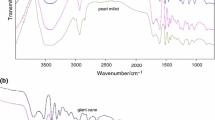Abstract
Compounds acting as model biphenyl and phenylcoumarane structural units in the lignin molecule (dehydrodivanillin and dehydrodiisoeugenol) were investigated by thermal analysis. The results were compared with previously obtained data on the thermal degradation of model phenylpropane monomer units of lignin. It was found that the mechanism of thermal degradation of these models and the thermal stabilities of the bonds depend on the structure. The thermal stability of the models increases in the absence of reactive functional groups in the side chain.
Résumé
Étude thermique de composés modèles pour les liaisons structurales de type diphényle et phénylcoumaranne dans la molécule de lignine (déhydrodivanilline et déhydrodiisoeugénol). Comparaison des résultats avec ceux obtenus précédemment dans le cas de la dégradation thermique de composés servant de modèles pour les unités monomères de phénylpropane dans la lignine. Détermination du mécanisme de la dégradation thermique de ces modèles et de la stabilité thermique des liaisons suivant la structure. La stabilité thermique augmente en l'absence de groupes fonctionnels réactifs dans la chaîne latérale. La liaison de type phénylcoumaranne est thermiquement la plus stable. On suppose un mécanisme avec radical libre pour la rupture des liaisons structurales.
Zusammenfassung
Modellverbindungen mit Biphenyl und Phenylcumaran Bindungen im Lignin wie Dehydrodivanillin und Dehydrodiisoeugenol wurden einer thermoanalytischen Prüfung unterworfen und die Ergebnisse mit jenen der thermischen Zersetzung von Phenylpropan-monomeren Modellen des Lignins verglichen. Es wurde festgestellt, daß der Mechanismus der thermischen Zersetzung und die thermische Stabilität der Bindungen strukturabhängig sind. Die thermische Stabilität der Modelle nahm mit Abwesenheit reaktionsfähiger funktioneller Gruppen an der Seitenkette ab. Die Bindung vom Typ des Phenylcumarans ist thermisch am stabilsten. Das Zerreissen der Bindungen scheint durch einen Mechanismus durch freie Radikale zu erfolgen.
Резюме
Проведено термограф ическое исследовани е соединений, моделиру ющих дифенильный и фенилкумарановый т ипы структурных связ ей в молекуле лигнина (дег идродиванилин и дегидродиизоэвген ол). Результаты сопост авлены с полученными ранее да нными по термораспаду моде лей фенилпропановых мономерных единиц лигнина. Показ ано, что механизм термическо го разложения моделе й и термоустойчивость С-С связей зависят от типа связи между моно мерами и от структуры боковой цепочки модели. Отсут ствие реакционноспо собных функциональных груп п в боковой цепи повыш ает термостабильность модели. Фенилкумаран овый тип связи являет ся наиболее термически устойчив ым. Высказано мнение о свободно-рад икальном механизме р азрыва структурных связей и сследованных соединений в условия х эксперимента.
Similar content being viewed by others
References
G. E.Domburg, V. N.Sergeeva and G. A.Zheibe, Khimiya drevesiny (in the press).
E. S. Freeman andB. Carrol, J. Phys. Chem., 62 (1958) 394.
G. E. Domburg, V. N. Sergeeva, M. Koshik andL. J. Salna, Izv. AN Latv. SSR, Ser. Khim., 4 (1968) 497.
M. Szwarc, Chem. Rev., 47 (1950) 75.
N. N.Semenov, O nekotorykh problemakh Khimicheskoi kinetiki i reaktsionni sposobnosti, Moscow, 1958, p. 30.
M. Koshik, L. Geratova, F. Rendosh andR. Domansky, Holzforsch. und Holzverwertung, 20 (1968) 15.
B. Solomon, G. Rozmarin, A. Biro andGr. Simionesku, Cellul. Chem. Technol. 1 (1967) 601.
A. J. Stamm, Ind. Eng. Chem., 48 (1956) 413.
G. E. Domburg, V. N. Sergeeva andA. N. Popov, Khimiya drevesiny, 6 (1970) 133.
S. Madorskii, Termicheskoe razlozhenie organicheskikh polimerov, Izdatelstvo Inostrannoi literaturi, Moscow, 1966, p. 307.
Author information
Authors and Affiliations
Rights and permissions
About this article
Cite this article
Domburg, G.E., Sergeeva, V.N. & Zheibe, G.A. Thermal analysis of some lignin model compounds. Journal of Thermal Analysis 2, 419–428 (1970). https://doi.org/10.1007/BF01911610
Received:
Issue Date:
DOI: https://doi.org/10.1007/BF01911610




